The risk to Europe from Islamist terrorism is stark.[REF] In 2017 alone, attacks have taken place in France, the U.K. (on multiple occasions), Italy, and Sweden. Army General Curtis M. Scaparrotti, commander of U.S. European Command, commented in March 2017 that the terrorist threat was “probably higher in Europe than any other part of the globe, with the exception of the places we’re actually physically fighting [terrorists], like Syria, […] Afghanistan, and Iraq.”[REF]
The main source of this threat is from the Islamic State of Iraq and al-Sham (ISIS), which has taken advantage of the refugee crisis in order to smuggle its operatives into Europe. Two such operatives were part of the cell that carried out ISIS’s coordinated attacks in Paris in November 2015, which killed 130 people. However, that is not their only way of carrying out attacks in Europe. ISIS is also increasingly using encrypted messaging apps to guide their recruits through the process of committing an attack. These plots have been described by European officials as being guided by ISIS via “remote control.”[REF]
ISIS is not the only group that threatens Europe: Al-Qaeda continues to do so.[REF] In January 2015, two terrorists trained by al-Qaeda in the Arabian Peninsula murdered 12 people in Paris, most of whom worked for the satirical Charlie Hebdo magazine. All the while, radicalized individuals and cells inspired by the ideology disseminated by ISIS and al-Qaeda—some having received training abroad, others essentially enthusiastic amateurs—continue to plot against Europe.
This Backgrounder studies all reported terrorist plots that took place in Europe between January 2014 and May 2017 and provides a statistical overview of some of the trends that have developed. It demonstrates that the problems Europe faces from terrorism are getting worse—and the threat is spreading throughout the continent.
In response, the U.S. should encourage European governments to devote more resources to counterterrorism and adopt a more aggressive stance to counter the threat internally. It should also assist Europe by working alongside it to keep military pressure on ISIS, al-Qaeda, and their affiliates around the world. There is also much to be done both by the U.S. and Europe in winning the war of ideas against Islamist ideology.
Data
In the 29 months between January 2014 and May 2017, there were 142 Islamist plots[REF] involving European targets—an average of 4.89 a month or one every 8.78 days. These 142 plots have taken place in 15 different countries: Albania, Austria, Belgium, Bosnia, Denmark, France, Germany, Italy, Kosovo, the Netherlands, Norway, Spain, Sweden, Switzerland, and the U.K.
While there have been multiple transnational arrests and networks, only one plot was transnational in its actual targeting. In November 2016, Kosovan authorities arrested 19 terror suspects allegedly planning attacks in both Kosovo and Albania. ISIS allegedly ordered this operation.[REF]
Year-by-Year Breakdown. The threat has increased year by year. There were 15 plots or attacks in 2014; 38 in 2015; and 59 in 2016. This year, until the end of May, there have been 30.
By way of comparison, there had been just three plots by the end of May 2014 (20 percent of that year’s total); 13 in May 2015 (34 percent of that year’s total); and 15 in May 2016 (25 percent of that year’s total). Therefore, it is likely that, by the end of May 2017, there will have been only—at most—just over one-third of the total plots that will ultimately be planned this year.
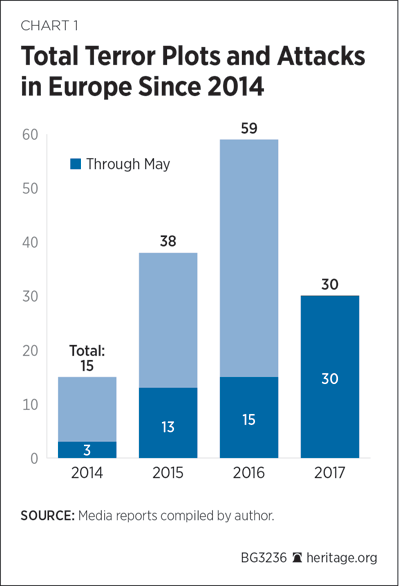
Month-by-Month Breakdown. Since January 2014, there have only been five months in which there was neither a plot thwarted nor an attack that took place. September 2016 was the month with the highest number of plots: 14. Eleven of these were in France, two in Germany, and one in the U.K. These plots resulted in four injuries and one death (all in France).
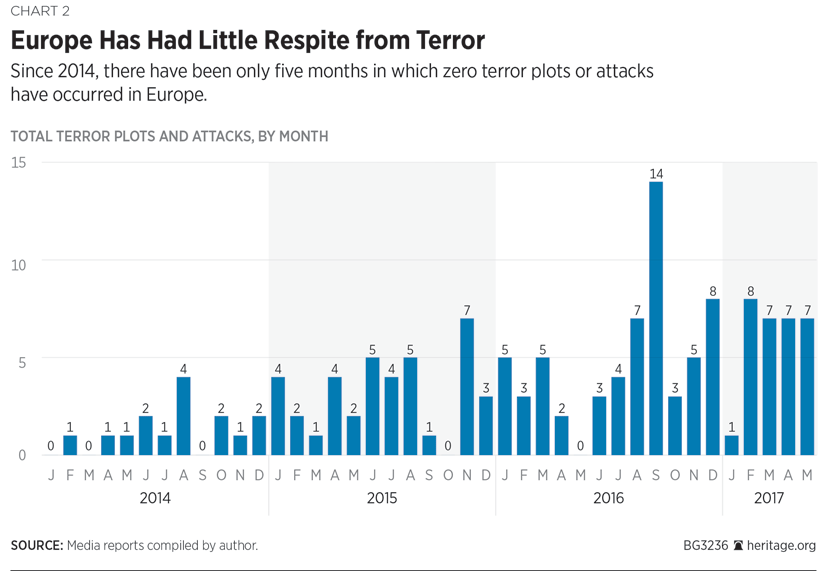
Gender
The vast majority of plots were carried out exclusively by men (118 plots, 83 percent). However, 24 plots (17 percent) were known to feature females either acting alone or as part of a larger cell (sometimes with men; on occasion in all-female cells).
The majority of the plots featuring females were based in France (14 of the 24, 59 percent). There were three plots featuring females in Belgium, Germany, and the U.K., and one in Denmark.
Year-by-Year Breakdown. There were only two plots featuring females in both 2014 and 2015—and a significant increase in this type of plotting from 2016 (13 separate plots). There have been seven so far in 2017. Therefore, the ratio of overall plots per year containing females was 13 percent in 2014; 5 percent in 2015; 22 percent in 2016; and currently 23 percent in 2017.
This rise in 2016—and the focus on France—is partially explained by five separate plots in September that featured many of the same individuals attempting multiple attacks on different targets. It is also partially attributable to the actions of Rachid Kassim, a French citizen based in Syria who was in electronic contact with females in France via the encrypted messaging app, Telegram. Seven of the 2016 plots containing females in France were connected to Kassim.[REF]
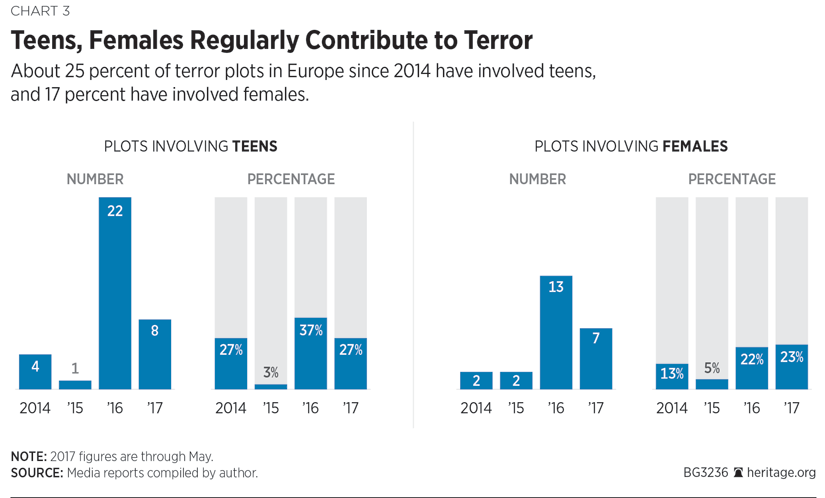
Age
Just under one-quarter of the plots (33 of 142, or 23 percent) featured teenagers or pre-teens. Over half of these (19, or 58 percent) took place in France. Germany and the U.K. were the other countries most impacted.
Year-by-Year Breakdown. There were five plots featuring teenagers between 2014 and 2015. There was then a major surge in activity in 2016, with 22 plots (37 percent of that year’s overall total) involving teens. There was a particular focus on France: half of the 24 plots France faced in 2016 featured teenagers. Nine of these 12 plots were connected to Rachid Kassim.[REF]
However, this phenomenon is not entirely attributable to Kassim’s activities. Kassim was killed in a missile strike in Mosul in February 2017, yet teenage terrorist planning has continued. Over one-quarter (27 percent) of the plots up until the end of May 2017 have contained teens. Only one was tied to Kassim.
Type of Attack
Plots involving explosives have proved most popular for Islamist terrorists targeting Europe. In total, explosives were to be used in 40 of the plots (28 percent of the total). Only six of these 40 (15 percent) led to injuries or deaths. In part, this is because the process of acquiring the materials necessary to build the bombs risks alerting law enforcement and intelligence agencies, and successfully constructing bombs usually requires a certain level of expertise and risk (e.g., acquiring training from terrorists abroad).
However, the six plots using explosives that were carried out led to approximately 808 injuries and 189 deaths (including the ISIS-directed attacks in Paris in November 2015; Brussels in March 2016; and the Manchester suicide bombing of May 2017). Therefore, explosives plots contain a low probability of success but will likely be repeated due to their potential lethality.
An edged weapon is the second most popular method of attack.[REF] Edged weapons were to be used in 35 plots (25 percent). There were casualties in 19 of the 35 edged-weapon plots (54 percent). Edged weapons, when used alone and not with any other type of weapon, are responsible for only 2 percent of injuries and 1 percent of deaths. Therefore, while edged weapon attacks may be hard to stop—in Europe, they have over a one-in-two chance of leading to some kind of attack taking place—they are not an especially effective mode of attack for Islamist terrorists in terms of their primary goal: mass casualties.
Firearms were to be used in 32 plots (23 percent). Twelve of these 32 plots (38 percent) led to casualties. Plots involving firearms led to 402 injuries and 158 deaths (the majority coming from the ISIS-directed attacks in Paris in November 2015).
Vehicles were to be used in six of the plots. None of these plots in Europe were thwarted: Terrorists had an alarming 100 percent success ratio. Furthermore, plots involving vehicles led to 551 injuries and 109 deaths. Therefore, although attacks that involve vehicles as a mode of attack are only responsible for 4 percent of the total number of plots, they have been responsible for 39 percent of the total number of injuries and 33 percent of deaths. Vehicular plots have been undertaken with more regularity from December 2016 onward.
Casualties
There were casualties of some kind (either injuries or deaths) in 41 plots (29 percent). These attacks led to approximately 1,417 injuries and 327 deaths.
Year-by-Year Breakdown. In 2014, two plots led to casualties (13 percent of that year’s total number of plots). In 2015, 12 plots led to casualties (32 percent of that year’s total). In 2016, 20 plots led to casualties (34 percent of that year’s total). This is a concerning, year-by-year rise. Up to May 2017, seven plots led to casualties (23 percent of that year’s total to that point).
Targets
Most commonly, terrorists specifically targeted civilians. There were 55 plots (39 percent) in which civilians were the sole, intended targets.
There were also occasions when very specific faith groups were targeted. On six occasions, it was Jewish targets; on two occasions it was Christians; and on one occasion it was Sikhs. On one occasion, another Muslim was murdered because ISIS-inspired attackers disapproved of how he practiced Islam. On a further two occasions, the plots were very clearly targeting those who supported freedom of speech (the Charlie Hebdo murders in Paris in January 2015 and a public event in Copenhagen a month later).
Some branch of the state being the sole target was also common: There were 31 such plots (22 percent). Of these, 14 focused on the police and 11 focused on the military. Two targeted both. There were four others plots against some form of state symbol (the royal family, prison staff, an embassy, and a politician). There were also plots with a mix of civilian and government targets. On one occasion, an attacker believed she was attacking a civilian, only for it to be a plainclothes policeman.[REF]
Contact with Terrorist Groups
In 64 of the 142 plots (45 percent), one or more perpetrators were known to have been in contact with a foreign terrorist organization (FTO). In 27 of these 64 plots (42 percent), this contact was solely electronic.
In 62 plots, the FTO in question was ISIS; on one occasion it was both ISIS and al-Qaeda’s affiliate in Syria (then known as Jabhat al-Nusra); and on one occasion it was al-Qaeda in the Arabian Peninsula, al-Qaeda’s affiliate in Yemen.
Year-by-Year Breakdown. The number of plots that saw contact being made with FTOs has increased year by year. This is unsurprising in some ways, as the number of plots being faced year by year has also increased. However, whereas between 2014 and 2016 there were also yearly increases in the ratio of these plotters that were in contact with ISIS (either electronically, having made personal contact, or being a formal member of ISIS), 2017 has—so far—seen quite a significant drop.
This suggests that although between 2014 and 2016 it was relatively easy for ISIS to be contactable (and to contact) operatives and sympathizers, it has become much harder in recent months. Alternatively, perhaps aspirant terrorists increasingly feel they no longer need theological approval or operational planning from ISIS in order to carry out their attacks.
The ratio of plots in which ISIS was in touch with a terrorist or terrorist cell but the communication was solely electronic (as opposed to face-to-face) has increased every year.
Reasons for this may include ISIS encouraging its supporters to carry out attacks in the West, rather than travel to its besieged caliphate in Iraq and Syria;[REF] governments able to more effectively crack down on travel to it via Turkey; ISIS’s increasing willingness to provide instruction to operatives electronically via encrypted messaging apps, rather than in person; and an increase in teenage plotters, who have primarily planned their attacks using this same method.
Combat Experience and Terrorist Training
In 30 of the 142 plots (21 percent), there was at least one individual or member of the cell who was known to have received terrorist training or had combat experience abroad.
Overwhelmingly, this training and/or experience took place in Syria. There were only three exceptions to this: a plot featuring a cell member who had fought in the Iraq conflict that began in 2003; a cell featuring those who had trained in Yemen; and one cell featuring those who had trained in Pakistan.[REF] Therefore, 90 percent of all plots featuring cell members who had trained or fought abroad were tied to Syria. These plots have been focused on eight different countries: Belgium, France, Germany, Kosovo, the Netherlands, Spain, Switzerland, and the U.K. Yet of the 30 plots launched by those who have been trained or fought abroad, 22 (73 percent) were against France (9), the U.K. (7) or Germany (6).
Five of these 30 plots (17 percent) led to casualties. This is a comparably low number when compared to the number of plots overall: There were casualties of some kind (either injuries or deaths) in 35 plots in which there was no training at all. However, the five plots that were successfully executed led to approximately 694 injuries (49 percent of the total of all injuries since January 2014) and 178 deaths (55 percent of the total of all injuries since January 2014). Therefore, while these types of plots may have low success rates, they are particularly devastating when they occur.
Where known, there was a clear preference for targeting civilians (43 percent of plots involving those who have trained or fought abroad).
In 17 of these plots (57 percent), firearms, explosives, or a combination of the two were to be used—a clear sign that the training these operatives received was to be put to use. There was a noticeable lack of the use of edged weapons, which seem to be relied upon by untrained operatives.
Plots containing those who trained or fought abroad were plentiful in the years between 2014 and 2016, with 2015 alone featuring thirteen such examples (43 percent). However, in 2017 there has been a drop in these plots. It is unclear if this is an anomaly that will alter as the year develops; if it signifies that ISIS has made attacks in Europe less of a priority (which is unlikely); or if it is becoming increasingly incapable of launching attacks in Europe using operatives trained by them.
Year-by-Year Breakdown. In 2014, the threat from these types of plots was evenly spread between Belgium, France, and the U.K. (two plots each, plus one in Switzerland). In 2015, however, the threat began to converge much more clearly on the U.K. and France, which faced four and five plots, respectively (69 percent of that year’s total from trained operatives)—with the Charlie Hebdo raid of January 2015 and November 2015 ISIS attacks in Paris proving particularly devastating.[REF]
By 2016, the situation had changed. Whereas Germany had not previously been targeted by those trained abroad, 60 percent of such plots in Europe in 2016 were now focused against it specifically, with all plots being planned by those who fought or trained in Syria. The remaining four plots were focused on Belgium, France, and the U.K.—also traditional terrorist targets.
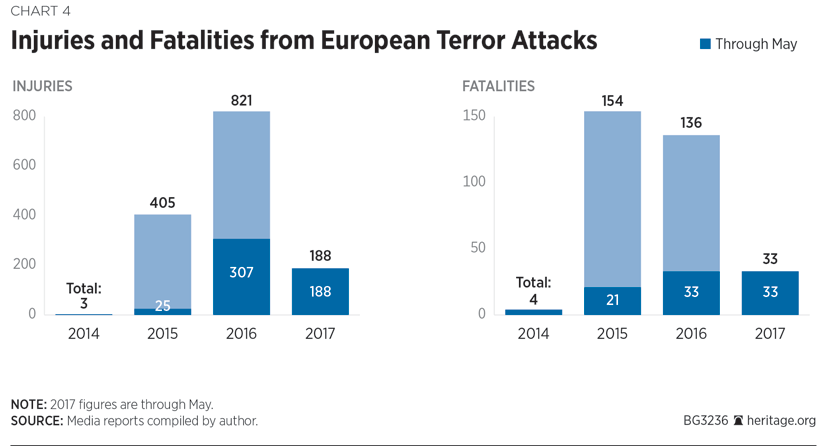
Refugees and Asylum Seekers
Twenty-two of the 142 plots (15 percent) featured refugees and asylum seekers, either planning attacks alone or as part of a larger cell.[REF]
Refugees and asylum seekers linked to these plots came to Europe from a range of countries: Afghanistan, Eritrea, Iraq, Morocco, Somalia, Syria, Tunisia, Russia’s Southern Caucasus, and Uzbekistan. There were also refugees from Algeria, although they entered Europe posing as Syrians.
Refugees or asylum seekers have planned attacks in nine countries: Austria, Denmark, France, Germany, Italy, Norway, Sweden, Switzerland, and the U.K. Yet overall, the threat to Europe from refugees and asylum seekers plotting has been concentrated in Germany—12 of the 22 plots (54 percent), with an additional case in which a suspected attack planned for Copenhagen was being organized from Baden-Württemberg in Germany.[REF]
In 15 of the 22 German plots (68 percent), one of the cell’s perpetrators was in direct contact with a foreign terrorist organization. This is disproportionately high: In total, only 64 of the 142 plots (45 percent) had one or more members known to have been in contact with a FTO.
Plots involving refugees or asylum seekers most commonly targeted civilians (59 percent) and, where known, explosives were the most popular weapon of choice (32 percent).
Year-by-Year Breakdown. In terms of the volume of these kinds of plots, the threat was relatively minor until 2016, the year after Germany allowed over 1 million asylum seekers and refugees into the country. There were only three plots featuring refugees or asylum seekers between 2014 and 2015 (although one of these was the devastating attack in Paris in November 2015). All were tied to Iraq.
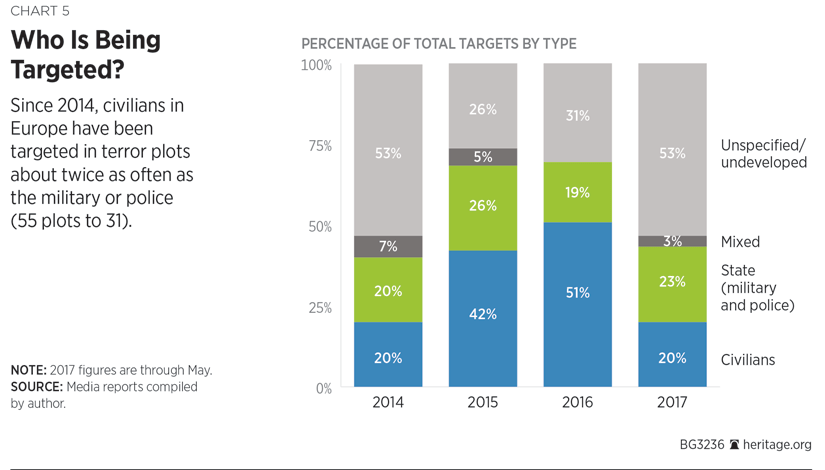
In 2016 alone, however, there were 16 plots. Eleven of these plots targeted Germany. The year 2016 also reflected a broad range of countries of origin for these asylum seekers and refugees: Syria (on nine occasions); Tunisia (twice); Algeria (although they had entered Germany with fake Syrian passports); and Afghanistan, Eritrea, Morocco, and Somalia (each on one occasion).
With one exception, all the Syrian refugee cells were known to be in contact with ISIS.
Ties to Criminality
Almost one-quarter (22 percent, 31 out of 142) of plots are known to have cell members who were involved in criminal but not terrorist-related activity prior to their arrest or to carrying out their attacks.
These plots had a disproportionate focus on solely government targets (13 out of 31, or 42 percent). In comparison, only 22 percent of the 142 plots studied targeted only the government. Targeting the police directly was most common: This occurred on six separate occasions. This may reflect the past of these participants. Those already tied to criminality are seeking to act out against the arm of the state most closely associated with preventing it.
In 11 of the 31 occasions (35 percent), the target was solely civilians. This is broadly in line with the overall number (38 percent of all plots studied targeted civilians only).
The most common type of weapon to be used in these cases was firearms. There were just three cases where explosives were intended to be used alone, although there were also four cases in which a combination of firearms and explosives were to be used together. There were nine total cases of edged weapons (one in conjunction with a vehicle). Therefore, firearms, edged weapons, and explosives were roughly all favored equally.
A disproportionately low number of plots (nine out of 31, or 29 percent) involving those with criminal pasts saw contact with FTOs. The overall percentage of plots that saw some sort of contact with a FTO was 45 percent.
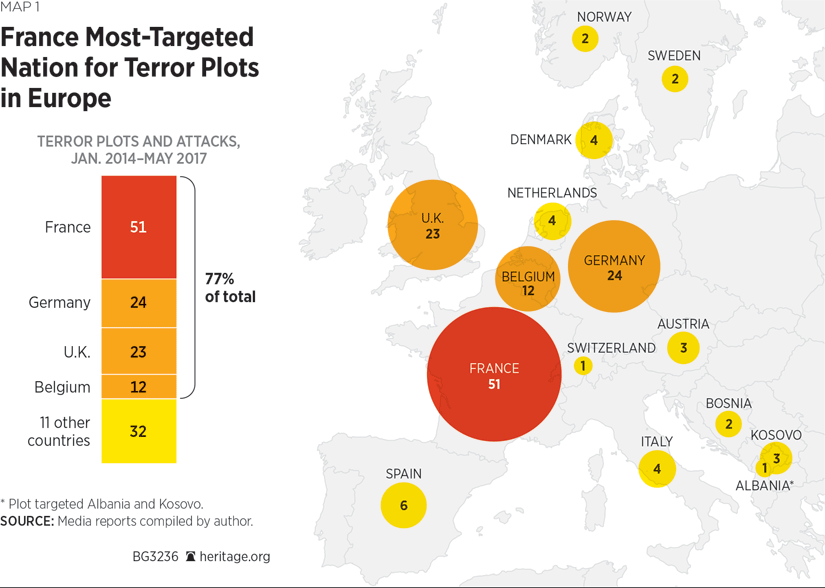
The Primary Targets: France, Germany, and the U.K.
The majority of the threat has converged upon three countries: France, Germany, and the U.K. More than two-thirds of all plots (69 percent) targeted one of these three countries. France is the country that is most commonly impacted (on 51 occasions), followed by Germany (on 24 occasions), and the U.K. (23 occasions).
France. The threat in France has consistently increased from year to year. The number of plots trebled from 2014 to 2015, and then doubled from 2015 to 2016. This is not just because of an increase in the number of plots facing Europe overall; over one-quarter (27 percent) of all plots against Europe in 2014 were focused on France. This was almost one-third (32 percent) in 2015, and then even higher in 2016: 41 percent.[REF] The ratio so far in 2017 is 37 percent.
In 20 (39 percent) of the known plots France faced between January 2014 and May 2017, there have been either injuries or deaths. The ratio of plots that led to casualties increased from 25 percent in 2014 to 58 percent in 2015 and then fell to 38 percent in 2016. It is currently at 27 percent in 2017. France is the only country to suffer casualties in every year studied.
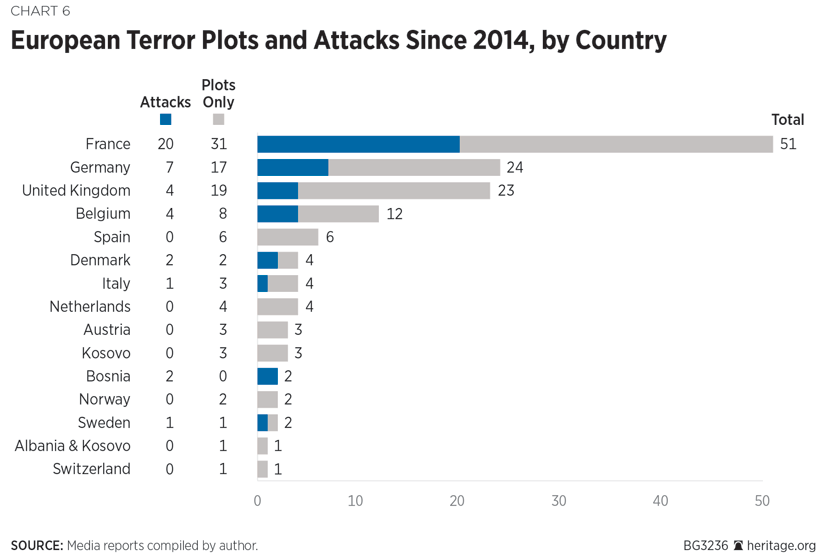
The type of weapons utilized in plots in France has subtly altered in the time period studied.
While there has consistently been one explosives plot every year, 2016 saw an increase in the use of edged weapons and a reduction in the use of firearms. This is mainly due to Kassim encouraging the use of these types of weapons; he was reaching out to those who were often untrained and young. He therefore needed to encourage the use of weapons that were readily accessible and easy to use. The year 2016 also saw vehicles being utilized in attacks twice (Yassin Salhi, who used a van to try and blow up a chemical plant in June 2015; and Mohamed Lahouaiej-Bouhlel’s use of a truck to kill 86 and injure 434 in Nice in July 2016).
There were roughly the same number of plots focused on either exclusively civilian or government targets (17 and 16, respectively), with two plots targeting a mixture of both. The remainder were unspecified or undeveloped. So far, 2017 has seen a drop in plots targeting civilians in France.
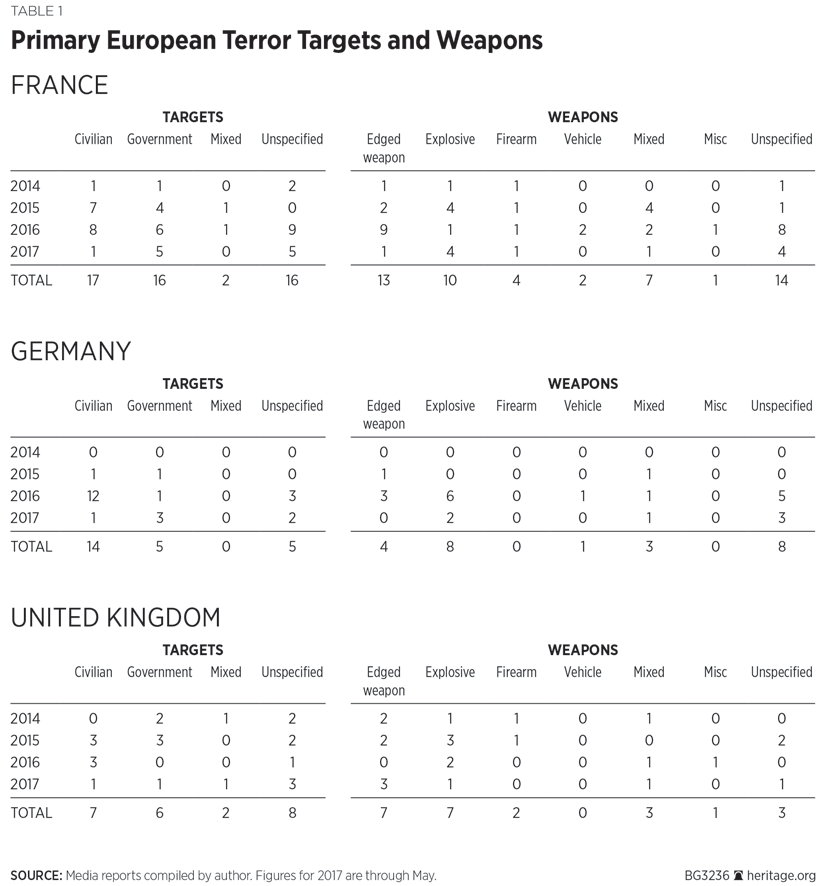
Germany. The increase in the threat to Germany is especially stark. According to Holger Münch, the head of the Bundeskriminalamt (Germany’s domestic central criminal investigation agency). Germany averted 11 attacks between 2000 and 2013.[REF] There were no plots in Germany in 2014, and only two in 2015. In 2016, this increased eightfold. There is a straightforward reason for this: In 2015, Germany took in over 1 million refugees and 2016 saw a surge in plots involving refugees.
- February 2016. German police arrested an ISIS-linked Algerian cell planning to attack Berlin. The head of the cell had recently entered Germany posing as a Syrian refugee, as had another suspect.
- March 2016. A suspected Syrian ISIS fighter who entered Germany with the refugee flow the previous August was arrested on suspicion he was identifying targets to attack in Berlin.
- June 2016. A Syrian ISIS cell that entered Germany with the refugee flow in 2015—and was allegedly planning a series of suicide bombings and shootings in Dusseldorf—was arrested.
- July 2016. Riaz Khan Ahmadzai entered Germany, claiming to be a refugee from Afghanistan. He carried out a knife-and-axe attack on civilians on a train in Wurzburg, Germany, injuring five.
- July 2016. Mohammad Daleel, an asylum seeker from Syria who was in contact with ISIS, carried out a suicide bombing outside a restaurant in Ansbach, Germany, injuring 15.
- August 2016. A suspected ISIS cell from Syria was detained on suspicion of planning an attack to coincide with the start of the German football season.
- September 2016. Three Syrians allegedly dispatched to Germany by ISIS in November 2015 in order to carry out an attack were arrested in the federal state of Schleswig-Holstein.
- September 2016. A 16-year-old Syrian asylum seeker was arrested at a refugee shelter after authorities discovered he was allegedly in electronic contact with an ISIS operative who was providing him with guidance on how to construct a bomb.
- October 2016. Jaber al-Bakr, a Syrian in contact with ISIS, was planning an attack on an airport in Berlin and was in possession of 1.5 kilos (3.3 pounds) of explosives. Al-Bakr, committed suicide in prison.
- December 2016. Anas Amri, a Tunisian asylum seeker who arrived in Germany in July 2015, injured 48 people and killed 12 by running them over with a truck at a Christmas market in Berlin. ISIS subsequently released a video of Amri pledging allegiance to ISIS emir Abu Bakr al-Baghdadi.
Germany faced more plots in 2016 alone than it did in the entire period between 2000 and 2015. While plots targeting Germany only comprised 5 percent of the total facing Europe in 2015, they comprised 27 percent in 2016. In over one-quarter of the known plots Germany has faced since January 2014, there have been either injuries or deaths (seven out of 24, or 29 percent).
Firearms have not featured in German plots, and the use of edged weapons appears only intermittently. Instead, there has been more focus on explosives: There were six such plots in 2016 and two in 2017, despite there being none in 2014 or 2015.
Unlike France, there is also much less interest in attacking government targets, such as the military or the police, and much greater focus on attacking civilians. Three-quarters (75 percent) of the German plots in 2016 were targeting civilians. However, there are signs that may be changing: Three of the five government-targeted plots in Germany took place in 2017 alone.
The U.K. The threat in the U.K. has remained steady, with no dramatic spikes or falls. The year with the highest number of plots was 2015 (seven). Four of these were linked to Reyaad Khan, a British citizen based in Syria who was killed in a drone strike in September 2015. This was the first time that the U.K. had ever killed one of its own citizens in a targeted drone strike.
Until the end of May 2017, in four (17 percent) of the known Islamist-inspired operations the U.K. has faced since January 2014 there have been either injuries or deaths. The most devastating was in Manchester in May 2017, when Salman Abedi killed 22 people and injured a further 116 people in a suicide bombing at a music venue.
One-third of all plots targeting Europe were fixed on the U.K. in 2014. This fell to 21 percent in 2015; 7 percent in 2016; and is at 20 percent so far in 2017. The drop in 2016 is mainly attributable to an increased ISIS focus on France and Germany, as well as Reyaad Khan’s death.
Plots involving solely explosives or edged weapons are most popular for terrorists. Government and civilians are targeted in roughly equal measure, yet it is actually most common for the target to be unspecified or undeveloped, suggesting British authorities are skilled in disrupting plots in their early planning stages.
Overall, however, the threat is especially diffuse and diverse in the U.K., and it is hard to discern any particularly compelling trends.
The Need for the U.S. to Assist European Security Efforts
The U.S. has a great stake in helping Europe improve its bleak security situation.
America has close and long-standing alliances in Europe, including countries that are also vital economic trading partners. The U.S. must also aspire to defend values that it shares with much of Europe and that are imperiled by the Islamists attacking that continent: democracy, equality, freedom (including of speech and of religion), human rights, and rule of law governed by man. The U.S. has helped safeguard such values in Europe for decades, committing itself militarily to do so repeatedly. Almost 350,000 Americans died in the two World Wars fought there, and the Western alliance, spearheaded by the U.S.–U.K. relationship, helped defeat the Soviet Union.
Europe also needs help in protecting the lives of Americans living in Europe threatened by this form of terrorism. In recent years, nine Americans have been murdered in terrorist attacks in Belgium, France, and the U.K.:
- Nohemi Gonzalez was killed during an ISIS attack on a restaurant during its coordinated attacks in Paris in November 2015;
- Bruce Baldwin, Gail Minglana Martinez, and Justin and Stephanie Shults were all killed at Brussels Airport as a result of ISIS’s suicide bombings there in March 2016;
- Brodie and Sean Copeland and Nicolas Leslie were killed in Nice in July 2016 after Mohamed Lahouaiej-Bouhlel used a truck to attack civilians watching Bastille Day celebrations; and
- Kurt Cochran was murdered when the car driven by Khalid Masood, who was targeting civilians on Westminster Bridge in London in March 2017, hit him.
With millions of Americans visiting Europe every year to live, work, study, or vacation, there is even more incentive to assist European security efforts.
Policy Recommendations
- Encourage Europe to take a more aggressive stance on counterterrorism. Europe does not have a grip on the terrorism threat it faces. All European countries must take a tougher line than they currently do—militarily, legislatively, and in their funding for counterterrorism efforts. In the essentially borderless mainland Europe, counterterrorism efforts are only as strong as the weakest link in the chain.
- Share intelligence with European partners and respect the principles of intelligence sharing. It is vital that intelligence flow as freely as possible between the U.S. and Europe. Recent U.S. intelligence leaks during the Manchester investigation were unhelpful and led to a temporary halt to intelligence sharing by the U.K. government. This cannot be repeated.
- Encourage intelligence reform in Europe. European countries should focus on encouraging achievable domestic intelligence reforms. The U.S. can provide assistance and advice to its European allies on the breaking down of domestic intelligence firewalls.
- Work with European governments to forge a new path in the war of ideas. The countering/preventing violent extremism approach is rife with problems, and a drastic rethink is required. This must include a refusal—both in the U.S. and Europe—to collaborate with even purportedly non-violent Islamists such as the Muslim Brotherhood and groups connected to it either practically or ideologically.
- Implore European governments to pursue both ISIS and al-Qaeda. European governments’ resources mainly focus on ISIS, an inevitable consequence of the number of attacks that group has committed or inspired in Europe. However, surveillance must continue of al-Qaeda-trained operatives based in Europe, and governments must be willing to fund the extra manpower this may require.
- Work with Europe to maintain military pressure on Islamist terror groups targeting the West. ISIS and al-Qaeda’s presence has spread throughout the Middle East, South Asia, and Africa. The military response that is required cannot just be confined to Afghanistan, Iraq, and Syria, but must also be extended—at a minimum—to Libya, northwest Pakistan, Somalia, and Yemen. Europe cannot allow the U.S. to take on this burden alone, however, and must step up its military efforts.
- Pressure the governments of individuals that have entered Europe illegally to accept the return of their citizens. European countries have faced difficulties in deporting asylum seekers who have no legal grounds for their claim. Tunisia, for example, is reluctant to take back its terror suspects who have managed to enter Europe. The U.S. should pressure these governments to accept the return of their citizens while encouraging European governments—where possible—to share relevant intelligence that will help the receiving country deal with potential security threats.
- Prevent Islamists targeting the West from controlling territory. As ISIS’s “caliphate” in Iraq and Syria is slowly dismantled, the West must do all it can to prevent such a situation arising again in the future. There are numerous reasons for this: Expelling ISIS from the territory it controls in the Middle East, for example, reduces its ability to train operatives and dispatch them back to the West.
- Back this up with capacity-building in areas of strategic priority. Neither ISIS nor al-Qaeda can be allowed to credibly present themselves as viable, alternative forms of governance in areas where they have a presence. Addressing local problems that Islamists exploit to gain popularity is common sense, as is promoting good governance, religious freedom, and respect for human rights in such areas.
- Retain focus on ideology. ISIS and al-Qaeda represent virulent strains of the political ideology of Islamism. Defeating these groups militarily will not signify the end of the war against Islamism until the entire ideology has been discredited and dismantled, and the failure of the ideology has been communicated to key audiences.
Conclusion
As recent events in the U.K. prove, Islamism poses a clear and present national security threat to Europe. Although this threat has mainly converged upon France, Germany, and the U.K., there have been plots throughout the continent. Over time, the plots have increased in frequency.
In responding, militarily defeating ISIS is clearly vital. Yet policymakers must also be cognizant of the fact that such a defeat alone would not mean the danger had passed. Most of the plotters in Europe are not actually in contact with ISIS and, if they are, much of that contact is increasingly electronic. The group also does not train the majority of plotters—although those that are trained clearly pose a pressing threat. Instead, most plotters are inspired by ideology.
The U.S. can and should help its friends in Europe face these challenges. However, there is also a limit to the U.S.’s ability to do so. An unflinchingly robust response to Islamism in Europe clearly must be led from within Europe. With over 1,000 injuries and over 300 deaths in the past three and a half years, this response cannot come soon enough.
—Robin Simcox is Margaret Thatcher Fellow in the Margaret Thatcher Center for Freedom, of the Kathryn and Shelby Cullom Davis Institute for National Security and Foreign Policy, at The Heritage Foundation.


